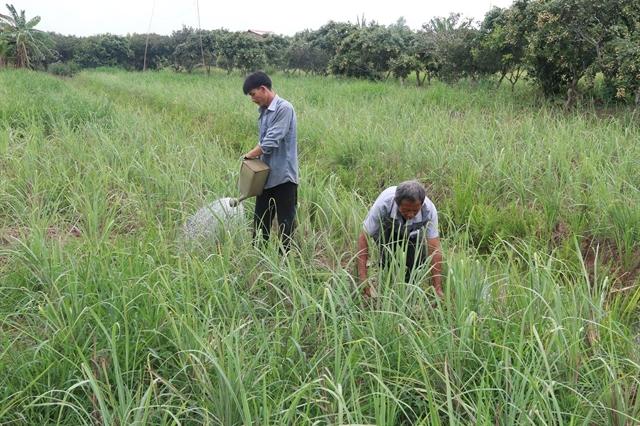 Society
Society


|
| Farmers in Tiền Giang Province’s Tân Phú Đông District tend their lemongrass fields. – VNA/VNS Photo Minh Trí |
TIỀN GIANG – Authorities in Tân Phú Đông District, the largest lemongrass growing area in Tiền Giang Province, are encouraging farmers to expand cultivation of the crop and produce more products from it.
The district is an islet located at the mouth of the Tiền River, a tributary of the Mekong, and is severely affected by saltwater intrusion in the dry season.
Since lemongrass is hardy and resistant to saltwater, the authorities have encouraged farmers to switch to this crop from rice on low-yield fields that support only one crop a year.
Farmers are also encouraged to grow the crop around their houses and gardens, along roads, and in fields and ponds.
Farmers in the district grow two to three lemongrass crops a year and earn VNĐ70 million (US$3,000) per hectare per year, three or four times their earnings from rice, according to the district Bureau of Agriculture and Rural Development.
Nguyễn Văn Hải, head of the bureau, said lemongrass requires little water or fertilisers and involves low labour costs, and many crops could be grown in a year.
The district has determined that lemongrass would be its key crop in restructuring to adapt to climate change, he added.
The area under lemongrass has increased from 830ha in 2015 to 1,900ha now with an annual output of 28,000 – 29,000 tonnes.
Agrarian and disadvantaged communes like Phú Thạnh and Phú Đông have switched to growing lemongrass on what used to be unproductive rice fields, helping many poor families escape poverty.
The cultivation of lemongrass also creates other jobs in the district like harvesting and cleaning the crop.
Women who harvest leaves earn VNĐ2 - 3 million ($85 - 130) a month.
The district has 30 establishments that buy lemongrass and sell it to other localities, mostly HCM City.
Lemongrass is in high demand as a spice and herbal remedy, but its prices are not steady since traders set them.
To add value, the district has created a collective brand name for its lemongrass.
It is also carrying out a project to produce essential oil from lemongrass leaves, use the residue after production as a substrate for growing mushroom and make full use of used substrate to produce clean soil for crops.
The project began in 2016 and will begin commercial production this year.
Lê Quang Khôi, director of the Tiền Giang Technical and Biotechnological Centre, said the project has helped diversify lemongrass products and improve incomes.
Nguyễn Văn Hùng, a farmer in Phú Thạnh Commune who learnt the technique of growing mushroom on lemongrass waste substrate, said one tonne of waste could be used to grow around 80 kilogrammes of rice-straw mushroom.
With a kilogramme of the mushroom fetching VNĐ60,000 ($2.5), he could earn VNĐ4 million ($170) from using a tonne of lemongrass waste, he said.
Hùng’s 2.5ha of land produces 75 tonnes of lemongrass stalks a year and 50 tonnes of leaves. He earns VNĐ190 million ($8,000) annually from the stalks.
If he can use his entire output of leaves to produce oil and substrate, his income would be very high, he added – VNS




